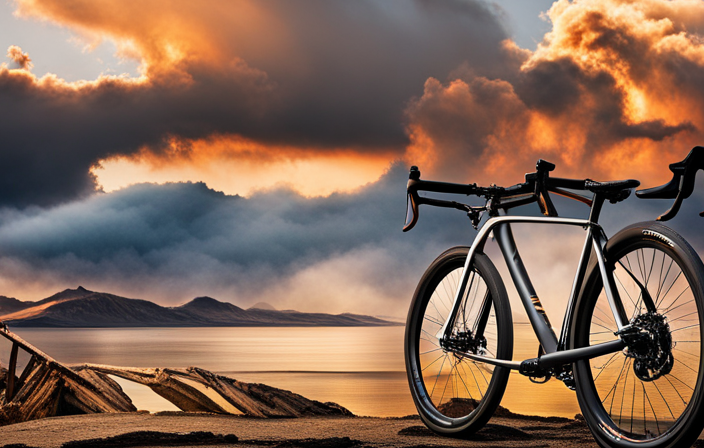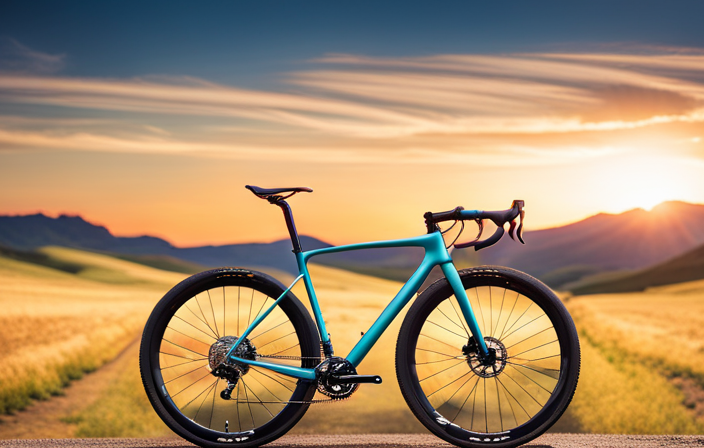Are you interested in exploring new paths and tackling grassy terrains or gravel trails on your bicycle? Unsure about which type of bike tire would work best for these challenging surfaces? You’re in the right place – this article has all the details you need to make a well-informed choice.
From tread patterns to tire width, tubeless vs. tube-type options, and even budget considerations – we’ve got you covered.
So let’s dive in and find the perfect tires for your grass and gravel riding adventures!
Key Takeaways
- Choose tires with durable rubber compounds for good grip and puncture resistance
- Opt for tires with wider profiles and lower pressure ratings for stability and shock absorption
- Look for tires with reinforced sidewalls for off-road durability
- Select tires with tread patterns suitable for off-road conditions, with tread depth and spacing that provide better traction and prevent clogging
Types of Bike Tires
You’ll need a specific type of bike tire for riding on grass and gravel. When it comes to choosing the right tires, there are two main factors to consider: tire materials and tire construction.
Tire materials play a crucial role in determining the performance of your bike on different surfaces. For grass and gravel riding, you’ll want tires made from durable materials like rubber compounds that offer good grip and puncture resistance. These materials provide better traction on uneven terrain, ensuring a smoother ride.
In terms of tire construction, you should look for tires with wider profiles and lower pressure ratings. This allows for increased stability and shock absorption when riding over rough surfaces like grass or gravel. Additionally, tires with reinforced sidewalls are recommended as they can withstand the impact of sharp objects commonly found off-road.
Transitioning into the next section about tread patterns, it’s important to note that while tire materials and construction are essential for grass and gravel riding, tread patterns also play a significant role in determining how well your bike grips these surfaces.
Tread Patterns
To ride on grass and gravel, opt for a tire with a tread pattern suitable for off-road conditions. When it comes to riding on uneven terrains like grass and gravel, having the right tread pattern is essential. The tread pattern refers to the design of the tire’s surface that comes into contact with the ground.
Two key factors to consider when choosing a tire for these surfaces are tread depth and tread pattern design.
Tread depth plays a crucial role in providing traction on grass and gravel. Deeper treads allow the tire to dig into loose surfaces, providing better grip and stability. On the other hand, shallow treads may not offer enough traction, causing slips and slides.
The tread pattern design also affects how well your bike handles on grass and gravel. Tires with widely spaced knobs or lugs tend to perform better as they can easily shed mud and debris while maintaining good traction. These patterns help prevent clogging, which can occur when riding through muddy areas.
In conclusion, selecting a bike tire with an appropriate tread pattern can greatly enhance your riding experience on grass and gravel terrains. However, there is another important factor to consider: tire width.
Tire Width
Make sure you choose a width that suits your riding style and the terrain you will be cycling on. When it comes to bike tires, the width plays a crucial role in determining how well it performs on different surfaces. A wider tire provides more stability and traction, especially on grass and gravel. It can handle uneven terrain with ease, giving you a smoother ride and better control.
Tire size is typically measured in millimeters, with wider options ranging from 35mm to 50mm or even more for off-road biking. The wider the tire, the more surface area it covers, distributing your weight evenly and reducing the chance of sinking into soft ground.
Another important factor to consider is the tire profile. Some tires have a rounded shape, while others are flatter. A flatter profile offers increased contact with the ground, providing better grip on loose surfaces like gravel or grass.
In conclusion, choosing the right tire width and profile is essential for riding on grass and gravel. Opting for a wider tire with a flat profile will give you enhanced stability and control over these challenging terrains.
Moving forward to tubeless vs. tube-type tires…
Tubeless vs. Tube-Type Tires
When deciding between tubeless and tube-type tires, it’s important to consider the advantages and disadvantages of each option. Tubeless tires have become increasingly popular among off-road riders due to their ability to run at lower pressures without the risk of pinch flats. By eliminating the inner tube, tubeless tires provide better traction and control on uneven surfaces like grass and gravel. Additionally, they tend to be more puncture-resistant as sealant can quickly seal small holes or punctures. However, there are some drawbacks to tubeless tires. They can be more difficult to mount and inflate compared to tube-type tires, requiring special equipment or expertise. In case of a larger puncture or sidewall damage, repairing a tubeless tire on the trail can be challenging.
On the other hand, traditional tube-type tires offer their own set of benefits and limitations. These tires are generally easier to install and repair since they don’t require specialized equipment or sealant. If you encounter a flat tire during your ride, replacing an inner tube is usually quicker than dealing with a tubelss setup. However, one disadvantage of using tubes is the increased risk of pinch flats when riding over rough terrain at lower pressures.
Considering these pros and cons will help you make an informed decision about which type of tire best suits your needs for riding on grass and gravel trails.
Moving forward into the next section about ‘tire pressure,’ it’s crucial to understand how it impacts your bike’s performance on different terrains.
Tire Pressure
Maintaining the appropriate tire pressure is essential for optimizing your performance on different terrains. When it comes to riding on grass and gravel, tire pressure plays a crucial role in ensuring a smooth and comfortable ride.
To begin with, you should check your tire pressure regularly to ensure it is within the recommended range. Riding with too low or too high tire pressure can negatively impact your bike’s handling and traction.
When riding on grass and gravel, it is generally recommended to have slightly lower tire pressure compared to riding on paved surfaces. This helps increase the contact patch of the tire, providing better grip and stability. However, keep in mind that going too low may increase the risk of pinch flats or sidewall damage.
To determine the ideal tire pressure for grass and gravel riding, consider factors such as rider weight, terrain conditions, and personal preference. It may require some experimentation to find the perfect balance that suits your needs.
In addition to maintaining proper air pressure, selecting tires with suitable tread patterns and widths can greatly enhance your performance on grass and gravel surfaces. Tires with more aggressive tread patterns provide better traction on loose surfaces like grass or gravel.
With an understanding of tire maintenance and selection tips in mind, let’s now delve into the importance of puncture resistance when riding off-road.
Puncture Resistance
Having puncture-resistant tires is crucial for a smooth and worry-free off-road biking experience. When riding on grass and gravel, it’s important to have tires that can withstand the sharp objects and rough surfaces commonly encountered in these terrains. Puncture resistance is a key factor to consider when choosing the right bike tire.
Here are three reasons why puncture resistance is essential for off-road biking:
-
Extended Tire Lifespan: Puncture-resistant tires are designed with reinforced layers that provide extra protection against punctures. This helps to extend the lifespan of the tire, saving you money in the long run.
-
Reduced Flat Tires: Off-road trails often contain debris like thorns, rocks, or glass shards that can easily cause flat tires. Puncture-resistant tires have special features such as thicker tread or added layers of protection, which greatly reduce the chances of getting flats.
-
Peace of Mind: Riding on grass and gravel tracks can be unpredictable, but having puncture-resistant tires gives you peace of mind knowing that you’re less likely to face sudden inconveniences such as flat tires.
With their ability to resist punctures and increase tire lifespan, these reliable bike tires ensure a more enjoyable off-road adventure. Speaking of durability… [transition into subsequent section]
Durability
To ensure a long-lasting and reliable off-road biking experience, you’ll want durable tires that can withstand rough terrains and sharp objects. Durability is an important factor to consider when choosing bike tires for riding on grass and gravel. These types of surfaces can be quite unforgiving, so having tires that are built to last is crucial.
When it comes to durability, there are a few key aspects to consider. First, the construction of the tire itself plays a significant role in its ability to withstand rough conditions. Look for tires with reinforced casings or additional layers of protection to increase their durability. Additionally, the tread pattern should be designed to provide optimal traction while also being resistant to wear and tear.
Maintenance is another important aspect of ensuring the longevity of your off-road bike tires. Regularly inspecting them for any signs of wear or damage is essential. Keeping them properly inflated according to manufacturer recommendations will also help prevent unnecessary damage.
Incorporating proper maintenance practices into your routine will not only extend the life of your tires but also contribute to a safer riding experience overall. In the next section, we will delve into the importance of sidewall protection when riding on grass and gravel surfaces without compromising safety and performance.
Sidewall Protection
Sidewall protection is crucial for ensuring the safety and performance of your off-road biking experience on rough terrains. When it comes to riding on grass and gravel, having a tire with strong sidewall construction is essential. The sidewalls of a bike tire are responsible for supporting the weight of the rider and absorbing impacts from uneven surfaces.
To provide adequate sidewall protection, manufacturers often use materials like Kevlar or reinforced nylon in the construction of their tires. These materials enhance the strength and durability of the sidewalls, preventing them from getting punctured or damaged when riding over rocks or other sharp objects.
In addition to material choice, tire sidewall thickness also plays a vital role in determining its ability to withstand rough terrains. Thicker sidewalls offer better resistance against cuts and abrasions, providing an extra layer of protection for your bike.
When choosing a tire for grass and gravel riding, it’s important to look for models that have robust sidewall construction and appropriate thickness. These features will ensure that your tire can handle the challenges presented by off-road trails without compromising safety or performance.
Transitioning into the next section about ‘rolling resistance,’ it’s worth noting that while sidewall protection is important, it’s not the only factor to consider when selecting a tire for grass and gravel riding. Rolling resistance also plays a significant role in determining how efficiently you can pedal over these terrains without expending excessive energy.
Rolling Resistance
One important factor to consider when riding on grass and gravel is how efficiently you can pedal over these terrains without expending excessive energy, which is influenced by rolling resistance. Rolling resistance refers to the force required to keep a tire moving forward on a surface. In the context of riding on grass and gravel, tires with lower rolling resistance are desirable as they allow for easier pedaling and increased efficiency.
To minimize rolling resistance, it is important to choose bike tires with an appropriate tread pattern. Tread patterns that feature smaller knobs or smoother surfaces tend to have lower rolling resistance. These tires have less contact with the ground, reducing friction and allowing for smoother movement. However, it’s essential to strike a balance between reduced rolling resistance and sufficient grip and traction.
In the next section about grip and traction, we will explore how tire tread affects your ability to maintain control on grass and gravel surfaces. By understanding both rolling resistance and grip/traction, you can make an informed decision when selecting bike tires that will optimize your riding experience on these challenging terrains.
Grip and Traction
Having good grip and traction is crucial when riding on grass and gravel surfaces, as it allows me to maintain control and navigate obstacles with ease. Traction on different surfaces can vary greatly, so it’s important to choose bike tires that are designed to provide maximum grip on grass and gravel.
When riding on grass, the tires need to have a tread pattern that can dig into the soft surface and provide sufficient traction. Look for tires with deep, aggressive knobs that can bite into the grass and prevent slippage. Additionally, having wider tires can distribute your weight more evenly, improving stability and grip.
For gravel surfaces, tires with a slightly different tread pattern are ideal. They should have smaller knobs that are spaced apart to allow for better rolling resistance while still providing enough traction. This will help prevent skidding or sliding out on loose gravel.
The importance of grip cannot be overstated when riding on these surfaces. Without proper traction, navigating corners or going up hills can become much more challenging. Good grip allows you to confidently maneuver through uneven terrain without worrying about losing control.
In conclusion, choosing bike tires with excellent grip and traction is essential for riding on grass and gravel surfaces. With the right tire choice, I can ride smoothly over these terrains with confidence and control.
Transitioning into the subsequent section about ‘comfort and suspension,’ finding the right balance between grip and comfort is key in ensuring an enjoyable off-road biking experience.
Comfort and Suspension
When riding off-road, it’s important to prioritize comfort and suspension for a smoother and more enjoyable experience. To ensure maximum comfort, it is essential to make proper suspension adjustments on your bike. This can be done by adjusting the preload settings of your suspension to match the type of terrain you will be riding on.
For grass and gravel surfaces, a softer suspension setting is recommended as it helps absorb the bumps and unevenness of the terrain.
Another factor that contributes to comfort is the seat. A comfortable seat not only provides cushioning but also reduces fatigue during long rides. Look for a seat with adequate padding and ergonomic design that suits your body type. Some seats even come with adjustable features like height and angle, allowing you to customize it according to your preference.
Transitioning into budget considerations, while investing in a high-quality suspension system and comfortable seat may seem like an expense, it’s crucial for riders who frequently ride on grass and gravel terrains. These upgrades significantly enhance your overall riding experience by providing better control, absorbing shocks, reducing vibrations, and minimizing discomfort.
Now let’s move on to how budget considerations play a role in choosing the right tires for off-road riding…
Budget Considerations
Budget considerations play a role in choosing the right tires for off-road riding because they determine the affordability and value of the tire options available. When it comes to finding cost-effective options, there are a few things to consider:
-
Researching different brands: Some brands offer budget-friendly tires that still provide good performance on grass and gravel surfaces. By exploring various options, you can find reliable choices without breaking the bank.
-
Considering second-hand options: Buying used tires can be a great way to save money while still getting decent quality. However, it’s important to carefully inspect them for any signs of wear or damage before making a purchase.
-
Comparing prices: It’s always wise to compare prices from different sellers or online platforms to ensure you’re getting the best deal possible.
By taking these factors into account, you can find budget-friendly tire options that meet your needs for off-road riding on grass and gravel surfaces.
Now, let’s transition into discussing recommendations for grass riding without missing a beat.
Recommendations for Grass Riding
To get the best performance on grass, you’ll want to consider tires specifically designed for off-road conditions. Grass riding requires a different set of techniques compared to riding on pavement or gravel. When riding on grass, it’s important to maintain a steady speed and avoid sudden changes in direction or braking, as this can cause the tires to lose traction. Keeping your weight centered and distributing it evenly between the front and rear tires will help improve stability.
Maintenance is also crucial when it comes to grass riding. Grass can get stuck in between the tire treads, affecting traction and handling. Regularly check your tires for any debris or grass buildup and remove them before each ride. Additionally, keeping your tire pressure at an optimal level is essential for proper grip on grass surfaces.
Transitioning into recommendations for gravel riding, it’s important to note that while grass presents its own challenges, gravel terrain requires a different type of tire altogether.
Recommendations for Gravel Riding
When it comes to riding on gravel, having the right bike setup is crucial. Gravel riding requires a bike with specific features that can handle the rough terrain and provide stability and control. One important component of a gravel bike setup is the tires.
The best tires for gravel riding are typically wider than traditional road bike tires, providing more traction and cushioning on uneven surfaces. There are several top gravel bike brands that offer excellent tire options for this type of riding. Some popular choices include Schwalbe, Continental, and WTB.
These brands have developed specialized tire designs that are specifically optimized for gravel riding, with tread patterns that excel in loose or rocky conditions. When selecting tires for your gravel bike, consider factors such as tire width, tread pattern, and durability.
A wider tire will provide better stability and grip on loose surfaces, while a more aggressive tread pattern will offer enhanced traction on rough terrain. Additionally, look for durable sidewalls to protect against punctures from sharp rocks or thorns.
In conclusion, when it comes to riding on gravel, having the right bike setup is essential. Choosing the best gravel bike brand and selecting appropriate tires can greatly enhance your performance and enjoyment on the trails. Now let’s move on to some final thoughts about biking on grass and gravel surfaces…
Final Thoughts and Conclusion
Ultimately, having the right bike setup and making informed decisions about your equipment can greatly enhance your overall experience when riding on grass or gravel surfaces. Riding on grass and gravel can be a thrilling adventure, but it does come with its own set of challenges. Let’s take a look at the pros and cons of riding on these terrains.
Grass riding provides a unique experience, allowing you to feel closer to nature. It offers a softer surface compared to gravel, which can be more comfortable for longer rides. However, it may also slow you down due to increased rolling resistance.
On the other hand, gravel riding offers more stability and traction than grass. It allows for faster speeds and is often preferred by riders who enjoy off-road cycling. However, it can be rougher on your tires and may require more maintenance.
To keep your bike tires in top condition for grass and gravel riding, here are some tips:
- Use wider tires with aggressive tread patterns for better grip.
- Inflate your tires properly to avoid pinch flats.
- Regularly check for any signs of wear or damage.
- Clean your tires after each ride to remove debris that could cause punctures.
Remember, proper tire maintenance is essential for maximizing performance and ensuring safety while riding on grass or gravel surfaces.
| Pros of Riding on Grass | Cons of Riding on Grass | Pros of Riding on Gravel | Cons of Riding on Gravel |
|---|---|---|---|
| Soft surface | Increased rolling resistance | Stability | Rougher terrain |
| Closer to nature | Slower speed | Traction | Requires more maintenance |
In conclusion, riding on grass or gravel surfaces can offer unique experiences but requires careful consideration of tire selection and maintenance practices. By following these tips and understanding the pros and cons of each terrain type, you’ll be well-prepared for an enjoyable ride.
Frequently Asked Questions
Can I use the same tires for riding on both grass and gravel?
Yes, you can use mountain bike tires for riding on both grass and gravel. They are designed to handle various terrains and provide good traction.
When it comes to tire widths, wider tires generally work better on softer surfaces like grass, as they distribute your weight more evenly and prevent sinking.
For gravel, a medium-width tire should suffice, providing a balance between stability and rolling resistance.
How often should I check and adjust the tire pressure for riding on grass and gravel?
I recommend checking and adjusting tire pressure before each ride on different terrains like grass and gravel. This is especially important to ensure optimal performance and stability.
Riding on uneven surfaces can put more stress on the tires, so maintaining proper pressure is crucial. Additionally, regular inspections for any signs of wear or damage are essential.
Keeping your tires in good condition will enhance traction, minimize punctures, and improve overall safety while riding.
What are some common causes of punctures when riding on grass and gravel?
Common puncture causes when riding on grass and gravel include sharp objects like thorns or rocks, low tire pressure, and improper tire installation.
To prevent punctures, it’s crucial to choose tires with thick tread patterns for better traction and resistance against sharp objects. Additionally, maintaining proper tire pressure is essential to avoid pinch flats.
Regularly inspecting tires for any signs of wear or damage can also help prevent unexpected punctures while riding on these surfaces.
Are there any specific tire features that can enhance grip and traction on grass and gravel surfaces?
Effectiveness of tread patterns on grass and gravel surfaces, as well as comparing different tire widths for improved performance on these terrains, is essential.
Tread patterns with deeper and more aggressive knobs provide better grip and traction on loose surfaces like grass and gravel.
Wider tires also offer increased stability and control, especially when navigating through uneven terrain.
Combining a suitable tread pattern with an appropriate tire width can greatly enhance your riding experience on grass and gravel surfaces.
Is it necessary to invest in expensive puncture-resistant tires for riding on grass and gravel?
Investing in expensive puncture-resistant tires is not necessary for riding on grass and gravel. There are alternative tire options that are more affordable but still suitable for these surfaces.
Look for tires with a slightly wider width and a tread pattern designed for off-road conditions, such as knobby or semi-slick tires.
To prevent punctures, regularly inspect your tires for any sharp objects embedded in them, keep them properly inflated, and consider using tire liners or sealant to add an extra layer of protection.
Conclusion
After exploring the different types of bike tires, tread patterns, tire widths, and other factors to consider, it is clear that choosing the right tire for riding on grass and gravel is crucial.
One interesting statistic to note is that according to a study conducted by BikeRadar, wider tires with aggressive tread patterns provide better traction on both grass and gravel surfaces compared to narrower tires.
So, when venturing off-road onto these terrains, it’s important to invest in wider tires with a suitable tread pattern for optimal performance and safety.









